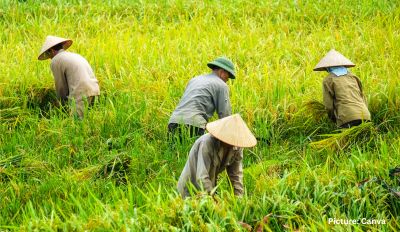Each year, Aarav Chavda, a former McKinsey analyst and mechanical engineer, goes scuba diving in the same Florida reefs. Over time, he has observed the corals turning white and species dwindling, except for the invasive lionfish. Local and federal authorities have tried various methods to eradicate the lionfish, a beautifully striped and spiny species with no natural predators in the Atlantic and Caribbean waters that preys on many other fish.
Chavda had a unique idea: turning the lionfish into a fashion statement. Along with two other diving enthusiasts, he founded Inversa, a start-up that transforms lionfish skin into attractive, supple leather. They expanded their efforts to include two other invasive species – Burmese pythons from the Florida Everglades and carp from the Mississippi River. Their innovative leather has been used by brands like Piper and Skye and Rex Shoes for products such as wallets, footballs, flip-flops, and a stylish python dagger and sheath.
The fashion industry’s environmental impact, including the companies that produce fabrics and clothing, is well-known. It’s responsible for up to 4 percent of global climate emissions and a significant amount of global water pollution, according to a McKinsey report. This presents a daunting challenge as humans need clothing and derive meaning from our fashion choices.
“It’s two sides of the coin,” says Monica Buchan-Ng, a sustainability expert at the London College of Fashion’s Centre for Sustainable Fashion. “[Clothes] can be this incredible creative force of self-expression and identity. But also we know that the way the fashion system works at present, it’s just destruction after destruction.”
Despite the industry’s negative impacts, its vast reach offers immense potential for innovation and change. Chavda is optimistic, stating that Inversa has removed 50,000 lionfish, Burmese pythons, and carp so far, and he hopes to increase this to tens of millions in the coming years. “I’m bullish,” Chavda says, “because I think the consumer cares.”
Julia Marsh, CEO of Sway, a company that makes seaweed-based plastic for companies like J.Crew, emphasizes the importance of “reuse and thrifting” in eco-friendly fashion. While cultural shifts towards lower consumption and stricter regulations are crucial, developing new, sustainable fabrics is also vital.
Fabric waste is a growing environmental issue. Clothing purchases nearly doubled from 2000 to 2015, with much of it ending up in landfills. Fast-fashion brands like Shein produce cheap, disposable clothing that exacerbates global waste. Many fabrics are harmful even before disposal. Synthetic fabrics like polyester shed microplastics into water systems when washed, and cotton farming often involves high pesticide use and forced labor. Leather production contributes to deforestation, water pollution, and high carbon emissions, while “vegan” leather often relies on fossil fuels.
Buying new, environmentally friendly clothing is currently difficult and expensive, but awareness is growing, leading to innovative solutions. Governments, especially in the EU, are starting to regulate fabric waste, pollution, and emissions. Efforts to create better recycling systems, repurpose old clothing, and develop non-toxic dye processes are emerging. Material development has also seen exciting advancements.
Uyen Tran, from Danang, Vietnam, grew up aware of the global impact of fashion waste. Her family shopped for brand-name clothing discarded by Westerners. After moving to the U.S. and studying at Parsons School of Design, she became interested in sustainable fabric manufacturing. Tran researched chitin, a natural polymer from shrimp shells, which she transforms into a leather-like material. Her company, TômTex, also uses chitin from mushrooms, which are popular among sustainable fabric innovators for their low environmental impact. TômTex has partnered with luxury brands like Peter Do to showcase its fully biodegradable fabric. “Waste is something that humans created,” Tran says. “For me, if we create something, it should biodegrade and decompose as nutrients back to the soil, so animals can feed on it, a tree can grow on it.”
Tran aims to scale up production to replace traditional materials significantly, needing substantial investment to build a factory. “Even brands that want to put in money … it’s not going to be $20 million,” she says. She is working on building brand relationships and pursuing venture capital.
Other sustainable fabric start-ups also seek capital, ranging from simple innovations like adding sustainably farmed nettle fiber to cotton blends, to complex bioengineering processes. Suzanne Lee, founder of Biofabricate, a consultancy for companies developing new materials, highlights the potential of biomaterials to have lower carbon footprints and less environmental impact. “We are at the frontier of new biomaterials,” Lee says, “which have the potential to have a lower carbon footprint, to use much less water and much less chemicals, and potentially biodegrade naturally at the end of their life, depending on how they’re treated.”
Some companies are succeeding. Japanese company Spiber raised about $64 million to mass-produce its plant-based, spider-silk-inspired fibers. However, others face challenges. Dan Widmaier, CEO of Bolt Threads, had to pause production on a mushroom-based leather alternative called Mylo due to fundraising issues. “The thing you learn about all these advanced materials is they always are super promising in the beginning, in the lab,” Widmaier says. “Can it work reproducibly at scale, meeting quality specs of the customer as they actually need them, meet their timelines and deliverables? Can it be financed to that scale? Those are the things that break all these.”
Earlier this year, Renewcell, a Swedish fabric recycling company, declared bankruptcy, causing concern in the industry. Renewcell had developed a process to turn old clothes into new cotton and had partnerships with major brands like H&M. Despite raising $10.6 million and opening a factory, it faced quality issues and insufficient orders to sustain production.
Lee believes the Renewcell failure might motivate brands to invest more in similar products. “We actually really need to back these things if we want them to happen,” she says.
Sustainable fabric companies are working to increase awareness. Finnish company Spinnova turns cellulose from wood pulp into biodegradable fiber, used by brands like Marimekko and Adidas. CEO Tuomas Oijala says, “I think that’s actually the thing that speaks best for itself: having brands publish actual product and being able to show that, hey, look, this is real. It works, it meets the needs of consumers and by the way, it’s also a good value for money deal.”
Inversa aims to reach a broader audience, confident their story will resonate with consumers. “I think when you tell the consumer, like, ‘Oh, buy this, you’re sustainable,’ you have to force them to acknowledge the guilt or the karma or whatever they were doing before,” Chavda says. “If you just tell them, ‘Hey, this wallet has saved these animals,’ or ‘You’re protecting these coral reefs,’ you just skip that whole piece.”
Inversa is also exploring other invasive species for their fabrics while maintaining partnerships with local fishing collectives, governments, and conservation NGOs to source invasive species responsibly. Chavda is optimistic about the future of sustainable fabrics. “We have different methodologies of doing it, but … whether that’s fiber made from seaweed or polyester spun in a different way that’s biodegradable, we’re all trying to do the same thing – make the planet a better place,” he says.










